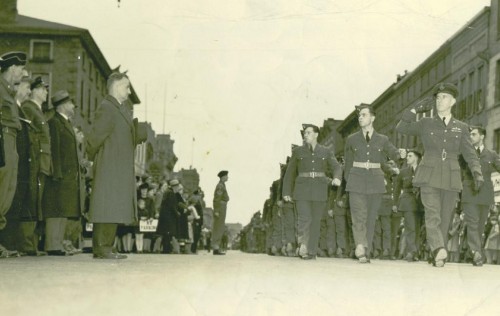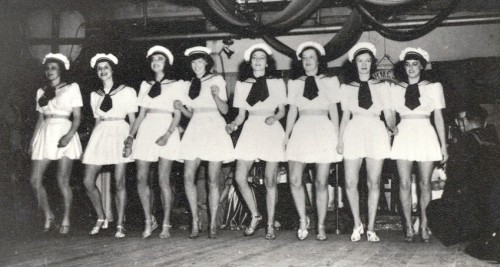With increased training, the C/O’s diary records even more damaged aircraft with an amazingly wide variety of causes:
“Two Harvards slightly damaged. F/Lieut. used excessive throttle to bring aircraft back on to the runway after his pupil had run off while taxiing at night. Immediately after returning to runway, the instructor taxied into a stationary aircraft which had lights on.” Then there were two Harvards damaged when a pupil “inadvertently switched off navigation lights and F/Sgt. taxied into his machine.”
On the September 25th, Course No. 57, one of the smallest classes up to now, graduated with one officer and twenty-four ratings receiving their wings.
In October, the 3rd Victory Loan Campaign began to support the Government’s requirements for the coming fiscal year, estimated at $3,900,000,000. Harvards from No. 31 dive-bombed over Napanee at mid-day, dropping leaflets and in Kingston, nine Harvards did a flyover and a group of sixty airmen joined in the parade.
A contingent of thirty men from the Gananoque Airport, led by F/O W. S. Matthews, marched in the Brockville campaign parade with what was described as, “a smartness and efficiency which did great credit to all those who took part, even drawing effusive compliments.

A/LA R. Breingan – October 11, 1942
A/LA Robert Breingan, died of severe injuries after crashing near the home of Miss Marie Dowling of Enterprise. The pupil had been practicing aerobatics and while attempting a roll off the top of a loop, he got into a spin and failed to recover. When Miss Dowling saw how badly injured the pilot was, she telephoned the local doctor and told the telephone operator the number of the aircraft and asked her to notify the airport. Mr. A. J. Finn and Mr. Emmett Dillon who lived in the area also witnessed the crash.
Twenty-two-year-old A/LA Breingan was the son of Robert and Charlotte Breingan of Port Alaviri, Napier, New Zealand and is buried at Cataraqui Cemetery.
“We have been extremely lucky with C.O.’s”
Group Captain C. F. LePoer Trench arrived on posting from the U.K. on October 15 and assumed command of the station on the 20th. His service began in 1916 and continued up to the present time, including service in India and Egypt. In The Pioneer he was described as having a charming personality, but others held a different view. An ex-Sergeant said G/C LePoer Trench was remembered by all as the “old-school-tie type”, and told a story that demonstrated what one would consider typical of a pre-WWII English officer:
“It was after a terrible snowstorm and the roads had not been cleared, but the C/O was determined to go into the city anyway and ordered his car. Shortly after they left the camp, the car got stuck and he sent his chauffeur to the nearest farm house, just before you reached the first bay. The farmer arrived with a team of horses and proceeded to hook them up to the car. Thinking the job wasn’t being done correctly, the C/O started to instruct the farmer in that way he had and finally told the farmer that he was stupid. Whereupon the farmer unhitched his horses, walked away, and left the C/O stranded.”
Two naval officers and thirty-nine ratings of No. 59 Course completed their course on November 3, and on the 6th, No. 60 Course graduated with two officers and thirty-nine ratings.

A cabaret and dance produced by the Women’s Association of the Royal Canadian Naval Volunteer Reserve was held at the naval barracks at the end of Princess Street. Dance numbers were presented by Daphne Hodgson, Joy Armstrong, Helen Beaumont, June Armstrong, Violet Miller, Genevieve Belcher, Geraldine Hanson, Katherine Connell, Sheila Hanson, Peggy Lesslie, Audrey Holloway, Lucy “Bunny” Clarke, Louise Henderson, Elizabeth Hanson.
Next Chapter: 22. Change Of Commanding Officer At NO. 1 R.L.G.